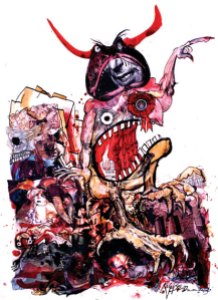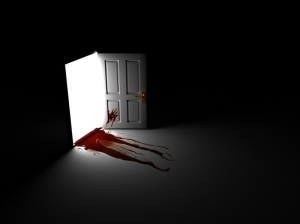 What is…
What is…
It’s a question that seems to pop-up fairly often, be it in forums, blogs, interviews, retrospectives, documentaries or anywhere else. At a casual glance, without taking any genre-to-genre polls, our favourite misunderstood stepchild, Horror, seems to bear the brunt of much of the cross-examining to which I refer. What is horror? What is spooky? What is fear? – the gist of it, asked a thousand different ways by a thousand different journalists, reviewers, profilers, documentarians, filmmakers, fans, even fly-by-night attention seekers looking for a fast way to get in the game, any game. Off the top of my head, I can’t think of another artistic field that’s so routinely subjected to critical analysis (and self-analysis) than the horror genre. The sad (or happily simple) truth is, of course, in the query itself. Regardless of how much debate, page space, or screen time the topic garners, the truth is as inescapable as fate itself. True fear is entirely subjective to its audience. To try and pin it down is nothing but all chase, no reward. To try and define or dissect it can only end in vain. That’s my take, anyway. A wise madman once said, “buy the ticket, take the ride,” and in horror’s case, we really have no choice. Said quote wasn’t from a genre guy, but when all’s said and done, in his own way maybe he was and we just didn’t recognise it. Again, it’s subjective. Oftentimes, we don’t see the dread coming until we’re caught in its shadow. And while hindsight may reveal the dark doorway we were being led to all along, the cold sweats and night terrors always hide in plain sight in the work, ready to be spotted whenever we’re ready to look for them.
At times, friends and colleagues have run concepts by me for a little feedback or input, which gives me mixed emotions for a couple reasons. 1: any creator worth their salt already knows quality stuff before a pen ever hits paper. 2: even if the pitch is shit, if it’s an idea they absolutely must express, the wheel’s already in motion and nothing we say will stop it. Luckily, I don’t think I’ve ever been in the position of having to honestly critique a friend’s god-awful abomination of a premise. They’re usually pretty solid. For the record, I’ve got a simple rule of thumb for these things. Got slashers? Vampires? Werewolves? Zombies? Aliens? Succubi? Other? Fine. Remove them from the equation entirely, then have another look. If there’s still a story there, proceed with vigour. Make it, then get it to the people. Someone, somewhere, won’t be able to put it down or turn it off. It doesn’t matter if you get fourteen maniacally devoted readers/viewers/listeners in the middle of nowhere. They were hungry, you served dinner, and that’s what it’s all about. Speaking of those aforementioned horror character staples, who’s to say we need any of ’em? Personally, I strive to see past the by-now familiar threat of zombies, wampyrs etc to find the story’s hook – the element of surprise, the unknown, the swerve that veers us off formulaic paths into uncharted territory – territory where anything’s possible. That’s where, both as a reader and a viewer, I like to be taken. Writers have only one duty to themselves and the reader, and that’s to find a way inside. Creepy-crawl or smash the door down, doesn’t matter. If we hoist the pen, the job description is to deliver the message. Horror, in particular, works on the gut level before all else, instinctual first & foremost, cerebral after. If it makes some folks uncomfortable, well, so be it.
“Stop questioning every little nuance. Let yourself go, enter the world of the work, accept it on its own terms.”
And, of course, if we ever do answer what is…?, we’re left with the seemingly universal two genre approaches to choose from. I think horror at its best and boldest contains far more surprises and tricks up its sleeve than the overly simplistic gore vs. atmosphere debate leads us to believe. But for this column’s purposes, let’s address those two. We could plant our protagonist atop a flight of rickety stairs, between a precarious free-fall and a salivating ghoul, or we could lock him/her in a room with nothing but the maddening sound of a leaky faucet and the scratching of some unseen menace outside the door. Both scenarios work, but how effectively ultimately depends on the protagonist. As we jump them through hoops, paint them into corners, and thread them through needles’ eyes, so the reader is stuck riding shotgun. That damn sure better be a character that makes the ride fun. And make no mistake, at day’s end, this is about fun. In real life, nobody wants to have a (insert antagonist of your choice) next door. We suspend disbelief, join with some characters that look like they’ll take us on an interesting ride, and away we go. Chills and ambiance, blood and guts, romance and emotion, tits and ass, who knows what awaits us on the next page? And who cares? Stop questioning every little nuance. Let yourself go, enter the world of the work, accept it on its own terms. You might be surprised, shocked, disgusted…even scared. And hey, if it’s not your cup of tea, you can always close the book or turn it off. But maybe…just maybe…the door will be locked when you turn around to leave. And down the rabbit hole you go. Relax. Breathe. You’ll be pulled a trillion different directions and predict nothing of what’s to come until it’s too late. It’s Horror. Buy the ticket, take the ride.
BC FURTNEY











2 comments
This is a perplexing issue. (A subset of the entire pigeon-holing and genrefication of the fiction market.)
But it does matter. Why? Because of the way we source our reading. We go to lists, we go into bookshops, we flick through amazon pages, and all are categorised to make it ‘easy’ for us.
We are social animals that rely on quick sterotypes and categories for just about everything we do. It’s how we make decisions.
That said, I believe horror is an Uber Genre. As you rightly say in your article, a creaking faucet can illicit as much horror as a the rickety stairs, and while horror-full, both scenes could exist in an adventure thriller, or a romance.
But when we say horror, we expect details at some point. We expect the tympanic scream and the tooth-pulling pliers – we expect the suspense to reach a climax.
William,
Good points all. While my subversive tendencies sometimes steer me far afield, it’s always with the best intentions.
I agree with you on the concept of the big payoff, and while any worthwhile tale in any genre or format abides by the idea, it’s perhaps most important of all in ours.
Having dabbled in the past with creating splashy gore-heavy climaxes as well as atmospheric anti-climaxes, I can say from experience that people seem to prefer getting whalloped with a hammer over being left scratching their heads most of the time. And rightfully so. It can be akin to paying for a deep tissue with happy ending and having the fire alarms go off before you do. Party foul.
However, what makes both sides of the page or screen suffer is when makers adhere so strongly to some of the by-the-numbers formulaic templates set in place before they entered the game that any chance of surprise (the most key ingredient of all) is squashed before the unveiling of the work and we, as an audience, are left feeling like marks with a stillborn piece of “entertainment” that we’ve probably seen/read better versions of hundreds of times.
So boiled down, I think people ought to close the book & leave the theatre with mouths agape, knowing they’ve experienced one helluva thrill. But it’s perfectly fine to deliver said bang at the story’s pace and in due time, as opposed to “the way it’s supposed to be done.” These days, far too many reach the soap box with a chance to make a dent, only to play it safe and revert to what they’ve seen before. That’s an accountant’s thinking, not an artist’s.
Writers, filmmakers, be brave. Forget the line drives, swing for the fences. Use everything you have. Go over the top. Worst that can happen is the ball is caught and it’s back to the dugout for you. But for that one fleeting moment, everyone held their breath to see if it would disappear.